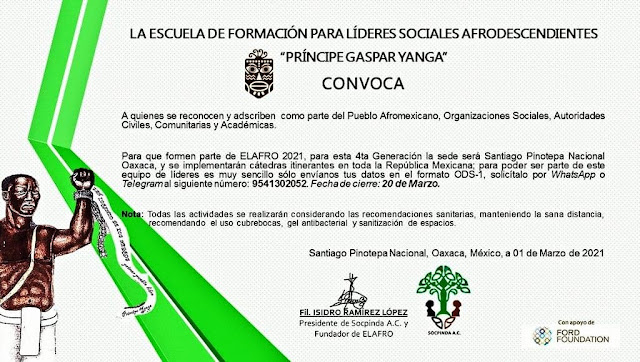-DONATARIA AUTORIZADA- 🌱✨ Sembrando Conciencia, ⚖️ Cosechando Derechos 🕊️🌍
Traductor
miércoles, 3 de noviembre de 2021
martes, 26 de octubre de 2021
Mexico’s First Liberated City Commemorates Its Founding
The City of Yanga was founded after a group of enslaved Africans, led by Gaspar Yanga, rebelled against colonial rule.
Located in east-central Mexico, the city of Yanga is named in honor of Gaspar Yanga, an African who was reportedly born in 1545 and who led the rebellion that led to its founding. Yanga, who was said to be a direct descendant of royalty in either Angola or Gabon, was captured and sold into slavery in Mexico, known at the time as New Spain.
Yanga was enslaved on the Nuestra Señora de la Concepción sugarcane plantation, in an area just 93 miles from Veracruz, a major port city originally founded in April of 1519 by Spanish conquistador Hernan Cortés, who designated it La Villa Rica de la Vera Cruz (The Rich Town of the True Cross). Veracruz very quickly became an important harbor for African enslavement in Mexico. Enslaved Africans and Indigenous people were captured and sold there into a brutal caste system that privileged Spanish colonialists.
The historian William H. Dusenberry noted that, in Veracruz, enslaved Africans lived under strict laws in New Spain’s viceroyal system. Those Africans who were able to liberate themselves from slavery were treated even worse:
…the Negro or Negro woman absent from the service of his or her master for four days shall suffer fifty lashes of the whip… and if they should be away more than eight days, for a distance exceeding one league, each of them shall suffer a hundred lashes, iron fetters weighing twelve pounds shall be tied to their feet with a rope, which they shall carry for two months and shall not take off under pain of two hundred lashes for the first offense; and for the second, each shall take two hundred lashes and shall not take the weights off for four months.
Yanga would be only one of many enslaved Africans to rebel against this horrific slave system.
Yanga’s rebellion, in the year 1570, was comprised of several hundred enslaved Africans, who, once free, fled to shelter near the summit of the Veracruz mountains. Roaming from Cofre de Perote to the Sierra de Zongolica and to the highest mountain in Mexico, the Pico de Orizaba, the self-emancipated rebels established a palenque—a small town––where they could live on their own. For 30 years the Yanguícos harvested their own foods (reportedly sweet potatoes, sugar cane, tobacco, beans, chile, squash, and corn) and raised livestock. Similar to other groups who roamed the highlands, they frequently used machetes and sticks to raid supplies from passing Spanish caravans.
Locals would transport goods in caravans that traveled from the Veracruz port to Mexico City. But as African and Indigenous people fled slavery and sought refuge in the surrounding mountain range, they took to raiding those caravans. These Yanguícos were a threat to the viceroyal system’s colonial order. In 1609, when a rumor started circulating that the Yanguícos were planning to overthrow local Spanish authorities in the neighboring towns and appoint Yanga as the king, the Spanish Crown’s Viceroy Luis de Velasco sent a battalion of a few hundred troops to subdue them. Both the Yanguícos and Spanish suffered serious casualties during the ensuing battles, but Yanga and his compatriots could not be defeated. Yanga ultimately negotiated a ceasefire: the Spanish Crown consented to a treaty that in 1618 allowed the Yanguícos to establish their own government and live in peace.
PARLAMENTO INTERNACIONAL DE LÍDERES AFROS E INDÍGENAS
domingo, 10 de octubre de 2021
¡En Tapextla somos ELAFRO 2021!
viernes, 1 de octubre de 2021
ENCUENTRO AFRO '21
domingo, 19 de septiembre de 2021
jueves, 16 de septiembre de 2021
domingo, 22 de agosto de 2021
miércoles, 7 de julio de 2021
viernes, 2 de julio de 2021
CONVOCATORIA ESCUELA DE LÍDERES "PRÍNCIPE GASPAR YANGA" 2021
VEN Y PARTICIPA DE ESTA INICIATIVA INTEGRAL A FAVOR DE LAS Y LOS NUEVOS LIDERAZGOS AFRODESCENDIENTES, SÚMATE A UNO DE NUESTRAS ÁREAS DE FORMACIÓN:
1. DECENIO INTERNACIONAL DE AFRODESCENDIENTES.
2. TERRITORIOS Y ANCESTRALIDAD.
3. DERECHO A LA EDUCACIÓN.
4. ARTICULACIÓN SOCIAL.
5. PROTECCIÓN CONTRA TODA FORMA DE VIOLENCIA, MALTRATO, ABUSO Y EXPLOTACIONES: FÍSICA, MENTAL Y/O SEXUAL.
6. REFUGIO Y PROTECCIÓN EN CUALQUIER PAÍS.
7. DERECHO A LA IGUALDAD Y NO DISCRIMINACIÓN.
8. DESARROLLO SOSTENIBLE.
9. CULTURA, DANZA Y MANIFESTACIONES ARTÍSTICAS.











